The Complete Guide to Ice Diving
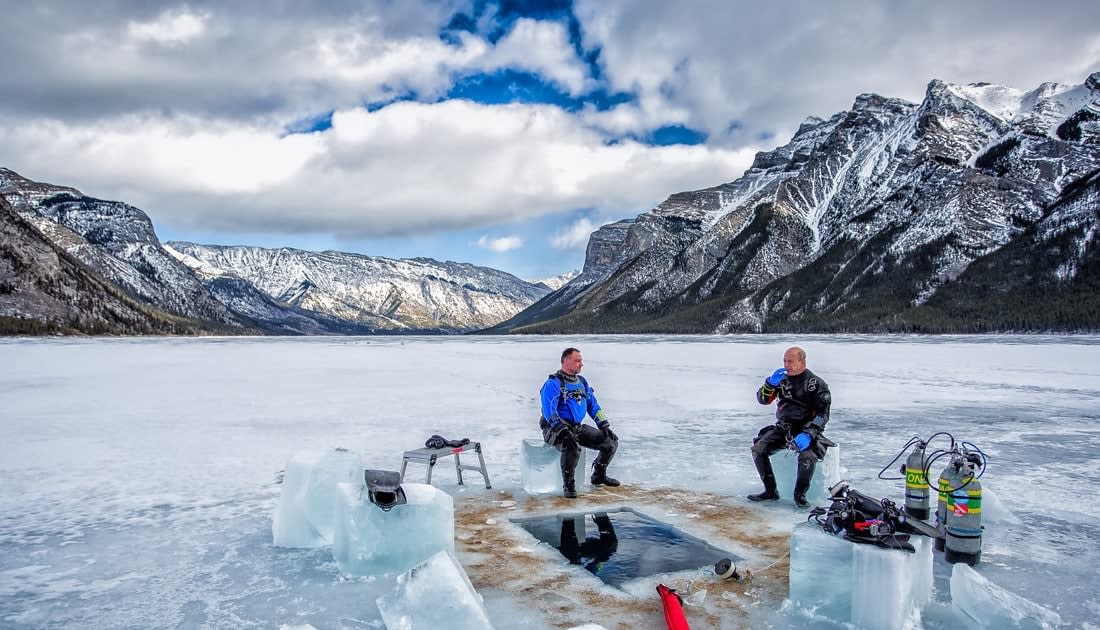
Diving fans read on to discover everything you’ve ever wanted to know in this complete guide to ice diving. Normal scuba diving is a favourite activity for vacationers who find themselves in warm Maldivian waters. But ice diving is a different breed of scuba. It’s for those that want to take their diving to the next level. Below the ice is another kind of world reserved for only the brave and is still unknown to many. Want to learn more? Read on!
What is Ice Diving?
The first topic in the complete guide to ice diving may seem fairly obvious- but many still wonder what exactly is ice diving? For those who don’t exactly enjoy the cold, Ice diving sounds like literally the least fun thing to try. But the more you know about ice diving, the cooler you will realize it is!
Simply put, ice diving is just what it sounds like – diving in ice water. There is however another kind of diving that is commonly confused with ice diving; cold-water diving. The first thing to know is that diving is only considered “ice diving” if it requires cutting a hole in a layer of overhead ice before entering.
Who can go ice diving?
Ice diving is usually done for recreational purposes, but also for scientific research. Researchers studying arctic wildlife, for example, might dive below the ice to observe Orca whales or seals in their natural habitat for specific research. Sometimes rescue efforts also require ice diving, and ice divers are sometimes also paid to dive in professional situations.

Ice diving is a beautiful and unique activity to check off your bucket list if you’re an avid diver. It is possible however, for a compelte beginner to go ice diving as well! The dangers of ice diving are real. However, ice diving courses and/or diving with properly trained professional instructors will help you to prepare in advance to make your dive as safe as possible.
Some of the potential dangers of ice diving include getting lost under the ice, hypothermia and frostbite, and regulator failure due to freezing. There can also be wild animals such as polar bears and sharks nearby. Diving into their world can be unpredictable.
Ice diving is generally for people who are serious, experienced divers. The harsh temperatures require a different kind of equipment, more preparation, and usually a larger team to assist. The requirements to train for recreational ice diving include a current Advanced Open Water certification, and to be at least 18 years old.
It is also ideal to have a familiarity with diving in a dry suit. A dry suit is different from a wet suit because your body stays completely dry, and you wear your clothes underneath. Drysuits are necessary to keepyou warm during an ice dive. They also tend to be bulky, and its a good idea to get familiar with them beforehand.
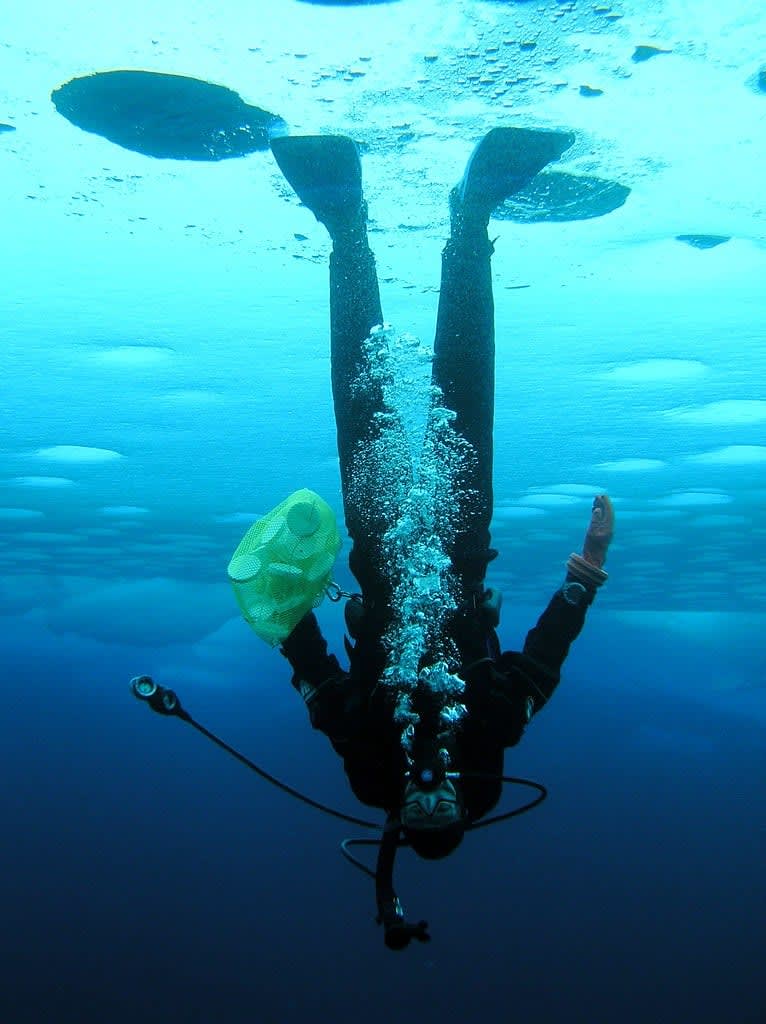
Can ice diving be for beginners?
If you’re excited by the idea of ??trying ice diving, but are not an experienced diver yet, don’t fret! Some instructors offer initiation ice dives, such as in the French Ski resorts Tignes or Val Thorens. No diving certifications are required to take part!
In these locations, you can dive into frozen mountain lakes, which are much safer than diving in the open water. Whether you are already an experienced diver or a complete beginner, you will be accompanied at all times by an ice diving instructor. Each dive usually lasts around 20 minutes, and you will remain within 1-3 metres of depth.
This is the perfect way to explore icy underworlds in a relatively safe way. Initiation dives usually cost between € 90-100, which includes all of the necessary equipment. Many first timers fall in love with diving after booking their first ice dive!

The ice diving equipment
Whether you are diving with an instructor as a beginner, or are a seasoned diver, the ice diving equipment will be similar, and includes all of the following:
- Drysuit
- Hood (most heat loss comes from the head)
- Boots
- Dry gloves (optional, make sure to get comfortable with using them)
- Usual diving attracts: Regulator, BCD (buoyancy control device), air tank
- Fins, mask
Using a regulator for ice diving
If you’re already a diver, using a regulator will be familiar enough already. If not, a regulator is the piece of equipement you use to breathe through. But when it comes to ice diving, moisture inside the regulator can cause it to freeze up.
To be fit for ice diving, regulators need to have a special environmental seal kit installed. The first step involves sealing the regulator tightly from air and water.
On top of that, there are many things to do to prepare a regulator for ice diving, which must occur in a specific order. For instance, the regulator should be kept in warm conditions before the dive. You must also make sure to avoid letting any moisture into the second chamber. Finally, it is important to ensure you do not exhale into the regulator before entering the water.
All of these technical details and procedures will be taught during a specialized course, or will be taken care of by your dive instructor if you choose a discovery ice dive.
Lastly, to dive properly into the ice, a chain saw will be required in order to cut the entry point in the ice. It should be done with skill and proper techniques. For instance, the holes are usually cut in a triangle shape to prevent breakage.
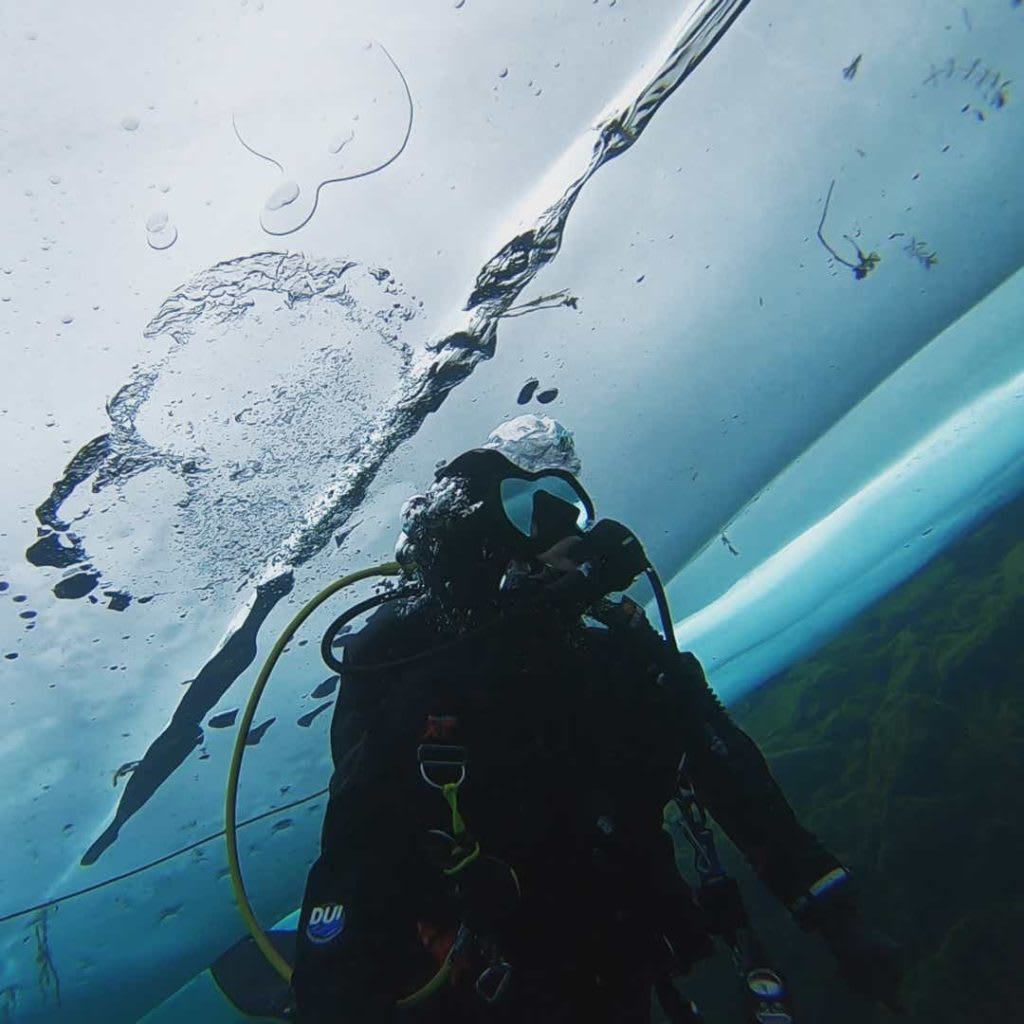
Photo credit: Chris Roxburgh
How it works?
Ice divers are always tethered to a safety line which will follow their path under the ice, and help lead them back to the point of entry. A member of the team usually holds the line to monitor the diver’s status. The line is used to communicate via tugs – 5 tugs, for instance, indicate a potential emergency and request to be returned to the surface. The safety line is clipped to a special harness to avoid any interference during the dive.
Recreational ice diving is usually limited to 30 minutes. Professionals often have more expensive, higher-quality equipment, larger teams, and more professional training. They can, therefore, stay down for longer, if necessary. However, the longer you’re down the greater the risks. The recreational time limit reduces exposure to freezing temperatures and ensures divers have enough air to stay down for the duration of the dive.
Iconic Dives

Antarctica
Diving in Antarctica sounds incredibly beautiful, but only for the incredibly brave, as well. One French diver and underwater photographer Laurent Ballesta, dove 230 feet below Adélie Coast, under East Antarctica’s Dumont d’Urville Station. The water temperature was -34 ° C, and he dove for a total of 5 hours straight at a time (he did it more than once!).
Laurent says his nerves took 7 months to recover from the subzero polar ice dive. The payoff, however, was an absolutely stunning, and once in a lifetime chance to see life below Antarctic waters. What he found was truly breathtaking- from octopus to Weddell seals, and fish of colors thought to be found only in tropical regions. He also photographed rare invertebrates. His photos possess an eery, otherworldly glow only the bravest and most passionate diving photographers can get; the ice divers.
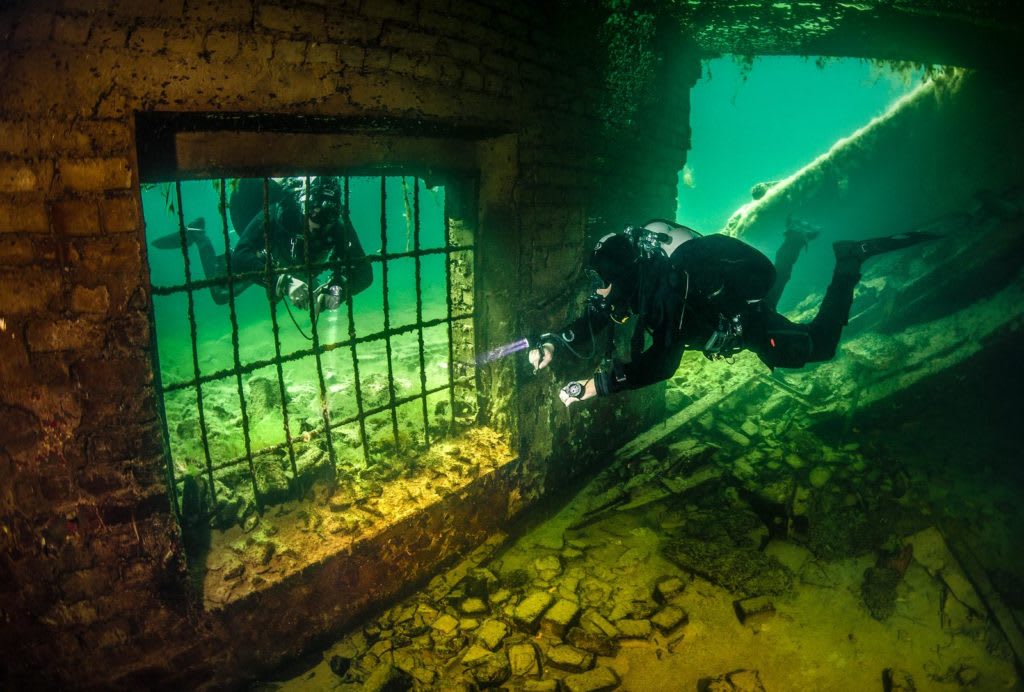
Rummu Quarry, Estonia
Estonia isn’t the first place most people think of when planning a trip. This former-Soviet territory on the coast of the Baltic Sea is almost entirely flat, with most of the terrain covered by vast forest. But this quiet country is home to a unique diving site, just a 45-minute drive from Tallinn, called Rummu Quarry.
Rummu Quarry used to be the location of a prison, as well as a limestone mining site. After limestone excavation stopped, the pumps that had been used to keep the quarry dry were shut down, and the area began to flood.
After the prison closed in 2012, Rummu Quarry became a popular spooky site for ice diving. Divers can explore the watery grave of the prison in icy former USSR waters. In the winter months, you will need to make an appointment with the Estonian Department of Tourism in order to visit.
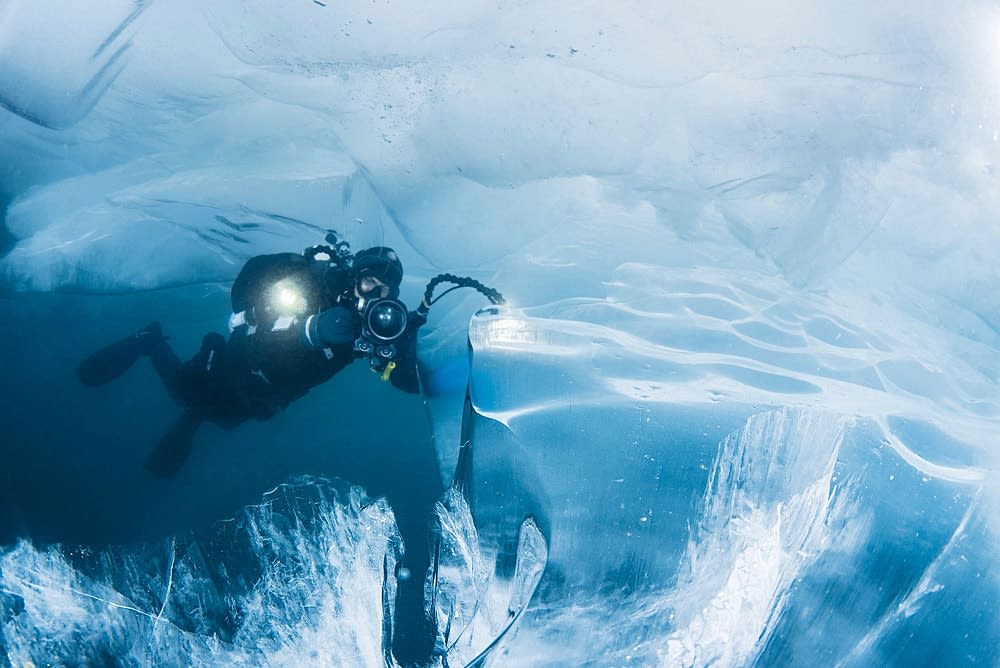
Lake Baikal, Russia
This is a truly epic ice diving spot, located in the vast, white winter wonderland of Siberia. Declared a UNESCO world heritage site in 1996, Lake Baikal is the largest freshwater lake in the world. Located in southern Siberia, Russia, it is also considered the oldest (25-30 million years), the deepest, and the clearest lake in the world!
Diving at this spot requires a significant amount of preparation and equipment. The ice here can get up to 1.5-2 meters (5-6.5 feet) thick. But all the preparation is worth it- the beauty of Baikal is unrivaled. Lake Baikal is also home to Baikal Seals, one of the only three species of freshwater seals in the world.
Most divers who come here make camp in the village of Khuzhir on Olkhon island. Before diving, they take part in a Russian tradition of drinking ice-cold vodka and raising their shots to Pay tribute to Boken, the spirit of the lake. An ice dive in the world’s oldest lake, with the company of Russian culture and tradition? Yes, please.
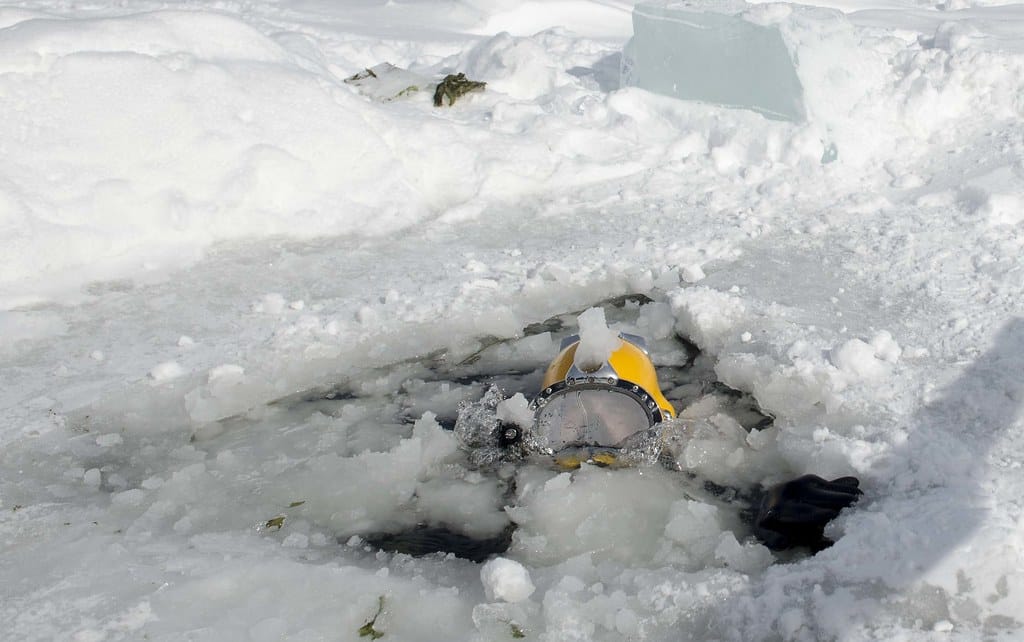
(US Navy photo by Chief Mass Communication Specialist Jeff Atherton / Released)
You now should have a pretty good idea of ??what ice diving is, what you will need in order to try it, and about some of the amazing things you can see if you do! Be sure to consult PADI for additional information about proper courses, or look here for beginner discovery ice dives to try it once! Have fun, and happy ice diving!